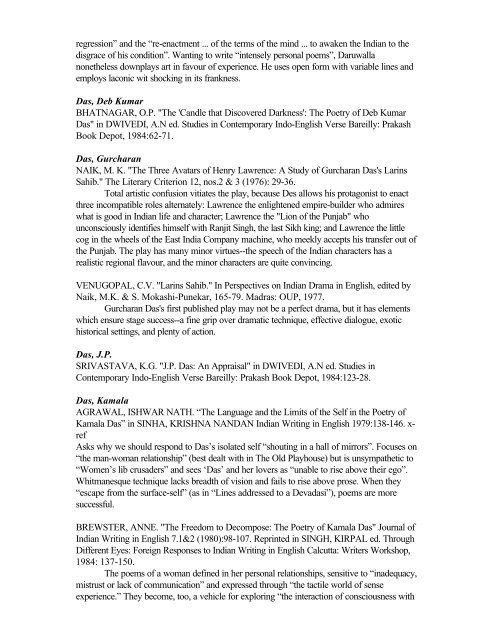india author m 1- a-nan - University of Wollongong
india author m 1- a-nan - University of Wollongong
india author m 1- a-nan - University of Wollongong
Create successful ePaper yourself
Turn your PDF publications into a flip-book with our unique Google optimized e-Paper software.
egression” and the “re-enactment ... <strong>of</strong> the terms <strong>of</strong> the mind ... to awaken the Indian to the<br />
disgrace <strong>of</strong> his condition”. Wanting to write “intensely personal poems”, Daruwalla<br />
nonetheless downplays art in favour <strong>of</strong> experience. He uses open form with variable lines and<br />
employs laconic wit shocking in its frankness.<br />
Das, Deb Kumar<br />
BHATNAGAR, O.P. "The 'Candle that Discovered Darkness': The Poetry <strong>of</strong> Deb Kumar<br />
Das" in DWIVEDI, A.N ed. Studies in Contemporary Indo-English Verse Bareilly: Prakash<br />
Book Depot, 1984:62-71.<br />
Das, Gurcharan<br />
NAIK, M. K. "The Three Avatars <strong>of</strong> Henry Lawrence: A Study <strong>of</strong> Gurcharan Das's Larins<br />
Sahib." The Literary Criterion 12, nos.2 & 3 (1976): 29-36.<br />
Total artistic confusion vitiates the play, because Des allows his protagonist to enact<br />
three incompatible roles alternately: Lawrence the enlightened empire-builder who admires<br />
what is good in Indian life and character; Lawrence the "Lion <strong>of</strong> the Punjab" who<br />
unconsciously identifies himself with Ranjit Singh, the last Sikh king; and Lawrence the little<br />
cog in the wheels <strong>of</strong> the East India Company machine, who meekly accepts his transfer out <strong>of</strong><br />
the Punjab. The play has many minor virtues--the speech <strong>of</strong> the Indian characters has a<br />
realistic regional flavour, and the minor characters are quite convincing.<br />
VENUGOPAL, C.V. "Larins Sahib." In Perspectives on Indian Drama in English, edited by<br />
Naik, M.K. & S. Mokashi-Punekar, 165-79. Madras: OUP, 1977.<br />
Gurcharan Das's first published play may not be a perfect drama, but it has elements<br />
which ensure stage success--a fine grip over dramatic technique, effective dialogue, exotic<br />
historical settings, and plenty <strong>of</strong> action.<br />
Das, J.P.<br />
SRIVASTAVA, K.G. "J.P. Das: An Appraisal" in DWIVEDI, A.N ed. Studies in<br />
Contemporary Indo-English Verse Bareilly: Prakash Book Depot, 1984:123-28.<br />
Das, Kamala<br />
AGRAWAL, ISHWAR NATH. “The Language and the Limits <strong>of</strong> the Self in the Poetry <strong>of</strong><br />
Kamala Das” in SINHA, KRISHNA NANDAN Indian Writing in English 1979:138-146. xref<br />
Asks why we should respond to Das’s isolated self “shouting in a hall <strong>of</strong> mirrors”. Focuses on<br />
“the man-woman relationship” (best dealt with in The Old Playhouse) but is unsympathetic to<br />
“Women’s lib crusaders” and sees ‘Das’ and her lovers as “unable to rise above their ego”.<br />
Whitmanesque technique lacks breadth <strong>of</strong> vision and fails to rise above prose. When they<br />
“escape from the surface-self” (as in “Lines addressed to a Devadasi”), poems are more<br />
successful.<br />
BREWSTER, ANNE. "The Freedom to Decompose: The Poetry <strong>of</strong> Kamala Das" Journal <strong>of</strong><br />
Indian Writing in English 7.1&2 (1980):98-107. Reprinted in SINGH, KIRPAL ed. Through<br />
Different Eyes: Foreign Responses to Indian Writing in English Calcutta: Writers Workshop,<br />
1984: 137-150.<br />
The poems <strong>of</strong> a woman defined in her personal relationships, sensitive to “inadequacy,<br />
mistrust or lack <strong>of</strong> communication” and expressed through “the tactile world <strong>of</strong> sense<br />
experience.” They become, too, a vehicle for exploring “the interaction <strong>of</strong> consciousness with

















